- Offensive Techniques & Strategies
Double Teaming
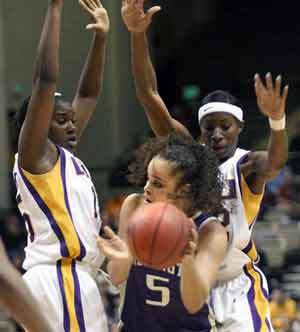
What to Discover or Recall . . .
One of the major weapons of disruptive pressure basketball is the double team or trap. Like all phases of the game, double teams and traps must be well executed and timed. In addition, to insure success, double teams and traps should take full advantage of Trap Zones, Pushpoints and Box Pressure.
Offensive Fundamentals Required
 Basic Defensive Concepts & Principles
Basic Defensive Concepts & Principles Defending Against Dribble Penetration
Defending Against Dribble PenetrationDouble Teams & Traps Take Teamwork

One defender must contain (block the dribbler's path), while the other defender attacks the ball. Players must know their roles when double teaming. If both defenders attack the ball or both contain, the offensive player will be able to split the trap. In containing the dribbler, the defender should take a charge whenever possible.

Influence the dribbler into a primary or secondary trap zone.
"LOCK UP" Do not allow the offensive player to split the trap.
Pressure the player with the ball with both hands, but do not foul.
Back Court Double Teams
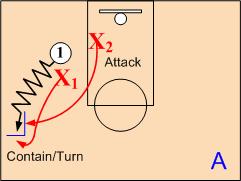
Once the inbounds pass is successful, defenders X1 and X2 then trap the ball handler O1. X1 and X2 must coordinate their trapping efforts. The defender guarding the dribbler must contain and turn while the defender off the ball attacks.
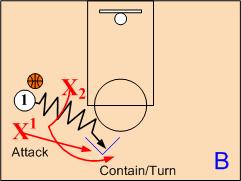
If the dribbler changes direction, the defenders change container and attacker roles. When the defense attacks and traps with teamwork, it can be difficult for the ball handler to advance the ball to half court.
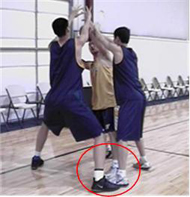
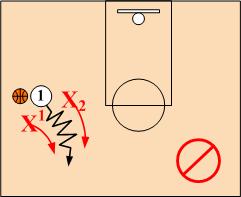
When trapping the defenders must "Lock Up" and not allow ball handler to split the defense.

Quick Helpside Rotations & Recovery
Be sure to employ quick helpside rotations when trapping. Once the trap is set, off ball defenders should be in position to deny all passing lanes out of the trap. Most passers will telegraph their passes. If/when pass is made out of the trap close out on the ball quickly. Trappers must sprint release and dive to basket into helpside I positions. Quick releases and rotations are a key ingredient to successful traps

All or None Principle

When trapping, do NOT ever go half way. However, players can and should fake a trap at anytime.
COACHING TIP
"Go Green"
Using the term 'GREEN' to indicate double team or trap is an easy way to communicate, and produces a variety of trapping scenarios. Simply by calling out a player's first name and adding "Go Green" such as "Pat, Go Green" will produce an instant double team or trap. Thus, the verbal command to "Go Green" provides the capability and coaching option for any player to double team at any time during a game.

Common Errors Made When Trapping
Trappers:
-
Indecision. Use the "All or None Principle." Either trap or don't trap. Defenders should never get caught going half way and then deciding not to trap.
-
Not "Locking Up" and allowing the ball handler to split the trap. Defenders must set hard traps with feet together.
Not building enough cushion (space), and allowing dribbler to drive by with only one dribble. The on ball defender must stay down in a 'nose on chest' position when guarding a dribbler.
Fouling. Pressure ball handler, but do not foul. "Trace" or follow the ball with both hands rather than reach.
Not influencing dribbler into a sideline trap zone. Influence the dribbler to sideline and do not allow dribble penetration into the middle (Red Zone) of the court.
Not containing dribbler. Allowing dribbler to drive by defender on the sideline or baseline side. Use teamwork on trap. One player contains the ball handler while the other attacks.
Not rotating quickly after pass is made out of trap. Sprint release as ball leaves passer's hands on close outs.
Non-trappers:
-
Not playing "UP" in the passing lane (between ball and opponent) and allowing critical sideline pass as trap is being set.
Allowing a pass into the middle of court once trap has been set.
Slow defensive transition. Not hustling into proper position before offense sets up.
Playing below the free throw line extended while the ball is in the backcourt.
Going back on defense with back to the ball.
Playing too tight on the weakside. Not establishing a "Helpside I" position creates too far of a distance to rotate.
Not anticipating pass out of trap and taking away passing lanes.
Trying to catch a pass rather than deflecting it.
Not closing out quickly after pass is made out of trap. Must rotate to nearest opponent as ball leaves passer's hands.
Not boxing out on shots and allowing the offense second efforts.
For Individual Defensive Drills - Click Here
Return to Player Development - Click Here
Return to Defensive Strategies - Click Here
Return to HoopTactics - Click Here
© 2026 HoopTactics All Rights Reserved.
